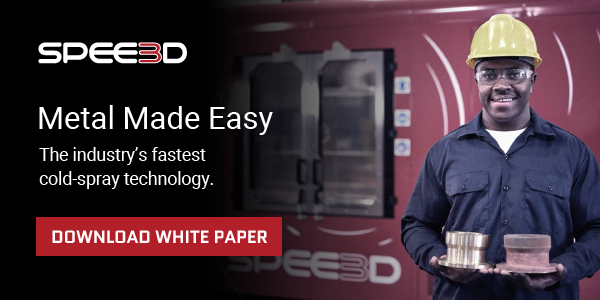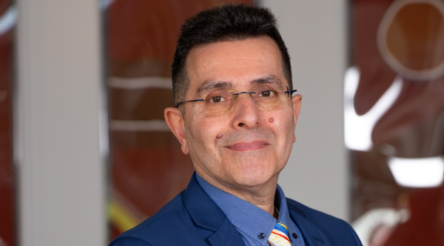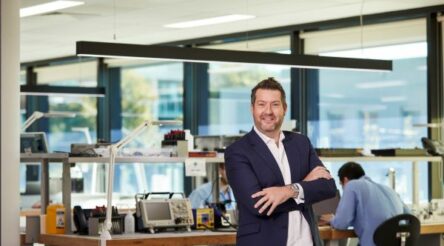The Australian AM business operating in a category of one

Sponsored
As seen through recent arguments over industry policy and various reports over the years – such as the results of a Parliamentary inquiry released in late-November – there are recommendations aplenty as to where and how local manufacturing can flourish.
It’s easy enough to find comments about where Australia shouldn’t try to compete. And the reasons might be familiar to you: too expensive, the skills have disappeared, our tariffs are too low, their tariffs are too high etc.
And in the background are manufacturers quietly getting it done and minding their own business.
According to Steve Camilleri, CTO and co-founder of cold spray additive manufacturing company SPEE3D, there’s an Australian approach to innovating that is under-appreciated.
“It’s an attitude of professionalism – ‘actually we understand the problem’ – and an attitude of irreverence – ‘you know what, maybe insert giant company’s name here hasn’t got this right,’” he tells @AuManufacturing.
“So we’re quite happy to jump into that frame. And that’s not normal. You don’t often see it around the world, but in Australia and New Zealand we both have that same attitude. And if you ask me I’d call this an agricultural attitude. This is farmers with fencing wire. This is in our [DNA]. I find that quite valuable.”
Camilleri puts an enduring crisis of confidence around manufacturing down to the exit of the last three car makers – “People are still smarting over that issue” – but is enthusiastic about how high-tech manufacturing can level the playing field when it comes to things like labour costs.
As a creator of it, Camilleri seems well-placed to comment on the potential of digitally-driven production technology. And as co-founder of a company whose value is increasingly being seen overseas, he seems well-placed to comment on what the nation can contribute in terms of innovation.
SPEE3D, which he co-founded with CEO Byron Kennedy in 2015, creates machines based on cold spray additive manufacturing.
Cold spray emerged in the 1980s, and uses a rocket nozzle and gas (the company uses compressed air) to blast particles (usually but not always metals) onto a surface. The particles deform and interlock without changing from solid to liquid and back to solid state, allows objects to be built 100 to 1,000 times faster than via laser-based methods.
The CTO describes three categories of cold spray in use currently: “This has never been done so formally, but certainly in my head this is the way it works.”
First is a hand-held method, and the second uses a robot to more precisely wield a nozzle and spray material onto a surface.
The third category is occupied by just one company, SPEE3D, and involves using cold spray to additively manufacture near-net-shape parts via software and highly automated equipment.
A new R&D frontier
According to the company it has about 50 of its units in the field currently.
 In October the Australian government announced an order of seven WarpSPEE3D printers to be provided to Ukraine. These will allow for the rapid manufacture of parts to be used by the Ukrainian army.
In October the Australian government announced an order of seven WarpSPEE3D printers to be provided to Ukraine. These will allow for the rapid manufacture of parts to be used by the Ukrainian army.
Camilleri says that deals with the UK and Japan governments for machines are coming up.
This follows a second project with the US Navy, this time for a Naval Systems Command (NAVSEA) project to Submarine Safety Program (SUBSAFE) quality standards.
SPEE3D and the Applied Research Laboratory of Pennsylvania State University (ARL/PSU) are partnering on the project, which involves developing new materials.
Though targeted at defence, the work has presented possibilities in the foundry industry, where Camilleri says skills are ageing out and being lost, partly due to perceptions of it as a “dirty” industry by younger people entering the workforce.
“There’s still a few around in Australia, which is fantastic. And there’s still a few around in the US and UK as well. But the industry’s definitely not growing,” he says.
“Where there’s high levels of skill required, what do you do?… It can be very difficult to make some of the alloys that are needed. So we’ve been asked to have a look at ways of using modern additive, advanced manufacturing technologies to make those materials, and we’ve been very successful with that.
“Of course we can’t claim that it was made the original way, but we’ve got to the point where I can show the materials to a professional metallurgist and they would find it very difficult to distinguish the material made with our process versus the foundry processes.”
Work on materials systems opens up another R&D frontier for the company, says Camilleri, and for the rest of the world.
“If I wanted to be very grand, I think there’s probably a whole kind of metallurgical handbook of ways to make material based on cold spray-type processes – that are in the first instance, solid state – that’s coming,” he enthuses.
Doubling in size every year
The last time we spoke to Camilleri was a little over a year ago, at the Land Forces 2022 event, where the company launched its XSPEE3D expeditionary printer for the defence sector.
This time around the news peg is the company’s relaunched website, as well as the appointment of a new Chairman, Adam Lewis, with Grant Anderson retiring.
SPEE3D is roughly doubling in size every year, with a current headcount of about 70. It is also in a transition from being an Australian to being a global company, says Camilleri.
What works for manufacturing in Australia is sometimes described in terms of occupying a high-value niche, and success stories can often be described in those terms.
For Camilleri and co, the niche is cold spray. And as the only company using it for manufacture, it’s a niche within a niche. It’s all theirs, and the world is taking notice.
“We can take an arbitrary shape that we’ve never seen before, put it into our software, calculate how the robot should move the nozzle and build that part from zero, and then reliably build the part up from zero the first time we try,” he explains.
“There’s no competitors, really, in that space.”
This article was written in collaboration with SPEE3D.
@aumanufacturing Sections
Analysis and Commentary Awards Defence Manufacturing News Podcast Technology Videos





